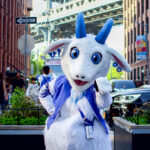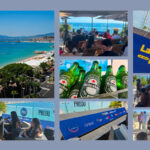By Lisa Avvocato, VP Global Marketing and AI Community, Sama
There’s nothing inherently festive about Coca-Cola. And yet, as a brand, it’s inextricably linked to the Christmas season, thanks to over a century’s worth of deliberate marketing effort. It’s always a wholesome, innocent affair. After all, who could argue with a kindly bearded Santa delivering gifts of brown cola bottles to well-behaved children on Christmas Eve — except, perhaps, dentists?
The recent holiday season, however, was different. Perhaps for the first time, the Coca-Cola Company found itself the target of a backlash over its Christmas ads, thanks to its use of generative AI.
This new ad is a remake of the legendary 1995 execution, so it’s hallowed advertising ground. But more importantly, it’s not made by humans at all, except for the ones writing the prompts for generative AI (Gen AI), and it doesn’t feature any real-life actors, either. Cue the ensuing dustup with denouncements that the ad is “a soulless and dystopian nightmare” and accusations that it might have “destroyed the spirit of Christmas.”
While that’s obvious hyperbole, the ad wasn’t perfect. On social media, viewers highlighted the 15-second clip’s various visual inconsistencies — from the wheels on the iconic Coca-Cola trucks, which didn’t turn but rather glided, to the AI-generated people, who always seemed a bit too big for their surroundings.
This wasn’t Coca-Cola’s first foray into generative AI advertising (it launched ‘Masterpiece’ over a year ago) but its first high-profile campaign using the technology. And it chose the festive season — which many consider sacrosanct — as the time to launch it.
Faced with this backlash, many brands in Coca-Cola’s situation would retreat. They’d issue a mild-mannered apology, including the usual platitudes like “we hear you” and “we got this wrong,” and then pull the ad. Not here. Instead, the company issued a statement to the New York Times saying that it’s committed to “always remain dedicated to creating the highest level of work at the intersection of human creativity and technology.”
The implication was obvious. Coca-Cola believes AI is here to say. It recognizes the importance of generative AI and will continue to push forward—no matter the backlash to its initial large-scale effort.
Coca-Cola has always been a trailblazer. It recognizes that Gen AI is an important technology, as evidenced by the five-year deal it struck with Microsoft in April, valued at $1.1bn, to deploy Gen AI across its entire business. Marketers have even leveraged Gen AI to create a new Coke flavor, and the company appointed a Global Head of Generative AI in 2023.
But that enthusiasm doesn’t change the fact that generative AI — particularly when it comes to the creation of rich media assets like video — is still in its infancy. Despite the rapid improvements we’ve seen over the past two years, there are still limitations that are yet to be overcome.
From this execution, for instance, we’ve learned the importance of the human touch, which means anything that feels unnatural needs to be manually edited, from the truck wheels to the too-fast pacing. If you give the technology free rein, you won’t get a compelling commercial at this stage of its capabilities.
Humans are integral to Gen AI’s success, not just as prompt engineers but in refining and perfecting the outputs. They are an essential quality control mechanism, and they’ll play a role not merely in reviewing content but also in creating the brand guidelines and messaging objectives that form the basis of every campaign. As Coca-Cola said, it’s about finding the optimal “intersection of human creativity and technology.” The brand has a proven track record of doing this with tech, using tools such as CGI, which it pioneered and is now a firmly established part of the marketing mix.
The same will be true for Gen AI, which offers enormous opportunities for marketers. It’s a powerful tool that allows quick, affordable content creation with visual sophistication that wouldn’t otherwise be possible on limited budgets. Companies like Coca-Cola will not be the only ones embracing AI to create TV ads; it’ll open up a whole new market. Global brands are experimenting more with longer-form digital content that pushes creative boundaries. Gen AI will enable them to react to news or trends at a lower cost quickly, or to create highly personalized content for audiences of one.
But while I’m convinced that Gen AI will become an essential part of the marketer’s toolbelt, I also recognize that there are fundamental ethical questions that need to be addressed, and those questions will only become louder as the technology improves.
Should brands be transparent if AI generates the content? Should AI be used for celebrity endorsements, voiceovers, and product placement? Or is that cheating the consumer? While I’m convinced that many of these questions will be organically answered over time, we can also expect to find clarity from legislators who will establish the rules for this technology. Colorado’s Consumer Protections for Artificial Intelligence bill is a good example of this. Brands should be transparent if AI generates content because consumers have the right to know when they are engaging with AI-driven material, especially in high-risk situations where the implications of AI decisions may not be immediately clear.
As these questions are resolved, brands will embrace Gen AI with the same vigor they adopted other marketing technologies — like CGI imagery or programmatic digital advertising. And while they’ll reap the rewards, the real winners of this moment will be those early adopters who engaged with Gen AI despite the unrefined newness of the technology, and the uncertainty of how it should be used.
As we head into 2025, those early adopters will be first to learn the important lessons of using Gen AI in this brave new world. They’ll use AI to push boundaries, prioritize human ingenuity and authenticity, and garner the lion’s share of attention. These trailblazing brands will understand that Gen AI is a tool; what matters is how you use it.
Ultimately, the real magic of marketing is found in the relationships we build and the narratives we craft, and there’s nothing more human than that.





